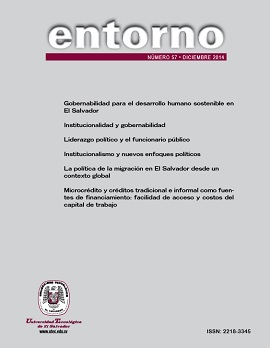Published 2014-12-01
Copyright (c) 2014 Manuel Menéndez Alzamora

This work is licensed under a Creative Commons Attribution-NonCommercial-ShareAlike 4.0 International License.
How to Cite
Abstract
Después del dominio en la Ciencia Política de las corrientes conductistas se produce, desde finales de los años setenta y principios de los noventa, una recuperación del institucionalismo, lo que ha sido denominado nuevo institucionalismo, algo que de manera simbólica se conoce como la reincorporación del Estado (Almond, 1985).
Esta reincorporación del Estado es un fenómeno ciertamente intenso en los Estados Unido s en la medida que el Estado nunca desapareció del todo, en la tradición europea, de la Ciencia Política (Peters, 2003); particularmente esto es cierto en la tradición española. Este artículo aborda el tema desde la historia y sus principales postulados, haciendo una reflexión al respecto de la institucionalidad del Estado y los nuevos enfoques políticos.
References
- lmond, G.A. (1988). The Return to the State, American Political Science Review, n.º82, pp. 853 a 874. P. B. Evans, D. Rueschmeyer y T. Skcopol, Bringing the State Back In,Cambridge, Cambridge University Press, 1985
- Arrow, K. (1974). Social Choice and Individual Values, Nueva York, Wiley [Traducción española: Elección social y valores individuales, Madrid, Ministerio de Hacienda, 1974 ] .
- Blais, A. y Dion, S. (1991). The Budget-Maximizing Bureaucrat: Appraisals and Evidence, Pittsburgh, Pittsburgh University Press.
- Buchanan, J.M. y Tullock, G. (1962). The Calculus of Consent: Logical Foundation of Constitutional Democracy, Ann Arbor, University of Michigan Press.
- Calvert, R. L. (1995). The Rational Choice Theory of Institutions: Implications for Design, en D. Weimer (Comp.), Institutional Design, Dordrecht, Kluwer
- Elgar, E. y Downs, E. (1994). Inside Bureaucracy, Boston, Little Brown, 1967
- Fiorina, M.P. (1996). Divided Government, Boston, Allyn and Bacon. (2.ª ed.).
- Fiorina, M.P. en J.L. (1988). Sudnquist, “Needed: A Political Theory of the New Era Coalition Government in the United States”, Political Science Quaterly, n.º 103, pp. 613 a 635.
- Hall, P. y Taylor, R. (1996). Political Science and the Three New Institutionalism, Political Studies, 44(4), pp. 936 a 957.
- Hall, O. (1996). Governing the Economy: The Politics of State Intervention in Britain and France, Nueva York, Oxford University Press, 1986; The Power of Economic Ideas, Princeton, Princeton University Press, 1989; Peter Hall y C.R. Taylor, “Political Science and the Three New Institutionalism”, Political Studies, n.º 44, pp. 952 a 973.
- Jones, C.O. (1987). Separate but Equal Branches: Congress and the Presidency, Chatham, Chatham House, 1995; Maurice Duverger, Les regimes semi-présidentiels, París, Presses Universitaires de France.
- Kiser, L. y Ostrom, E. (1982). The Three Worlds of Action: A Metatheoretical Synthesis of Institutional Approaches, en Elinor Ostrom (Comp.), Strategies of Political Inquiry, Beverly Hills, Sage, p. 179. Cit., por: B. Guy Peters, op. cit., p. 85.
- Krehbiel, K. (1991). Information and Legislative Organization, Ann Arbor, University of Michigan Press.
- Krasner, S. (1984). “Approaches to the State: Alternative Conceptions and Historical Dynamics”, Comparative Politics, n.º 16, pp. 226 a 246.
- Lijphart, A. (1984). Democracies: Patterns of Majoritarian and Consensus Government in Twenty-one Countries, New Haven, Yale University Press.
- Democracies: Forms, Performance and Constitutional Engineering”, European Journal of Political Research, n. 25, 1994, pp. 1 a 17.
- Lowndes, V. (2002). Institutionalism, en David Marsh y G. Stoker (Eds.), Theory and Methods in Political Science, Basingstoke, Palgrave, pp. 90 a 108.
- Marsh, J. y Olsen, J. (1984). The New Institutionalism: Organizational Factors in Political Life”, American Political Science Review, n. º 78, pp. 738 a 749.
- March, J. y Olsen, J. P. (1989) Rediscovering Institutions, Nueva York, Free Press, pp. 118 y ss. Cit. por. B. Guy Peters, op. cit., pp. 47 y 48.
- Marsh, D. y Savigny, H. (2004). Political Science as a Broad Church: The Search for a Pluralist Discipline, Politics, vol. 24, n.º 4, September, p. 157.
- Ostrom, E. (1994). Governing the Commons: The Evolution of Institutions of Collective Action, Cambridge, Cambridge University Press, 1990; Elinor Ostrom, R. Gardner y J. Walter, Rules, Games, and Common-Pool Resources, Ann Arbor, University of Michigan Press.
- Niskanen, W. (1971) Bureaucracy and Representative Government, Chicago, Aldine-Atherton.
- Peters, G. B. (2003) Institutional Theory in Political Science, Londres, Pinter, 1999 [Traducción española: El nuevo institucionalismo, Barcelona, Gedisa, p. 44.]
- Pierce, R. (1991). “The Executive Divided Against Itself: Cohabitation in France 1986-1988”, Governance, n. º 4, pp. 270 a 294.
- Polsby, N. (1968). “The Institutionalization of the U.S. House of Representatives”, American Political Science Review, n.º 62, 1968, pp. 144 a 168.
- Scharpf, F.W. (1997). Games Real Actors Play: Actor-centered Institutionalism in Policy Research, Boulder, Westview Press.
- Selznick, P. (1949) TVA and the Grass Roots, Berkeley, California University Press, Cit for B. Guy Peters, p. 47.
- Sobre la cuestión de la complejidad en las políticas implementadas: R.K. Weaver y B.A. Rockman, Do Institutions Matter?: Government Capabilities in the United States and Abroad, Washington, Brookings Institution, 1993.
- Sovereignty: An Institutional Perspective, ComparativePolitical Studies, n.º 21, 1988, pp. 66 a 94. S. Steinmo, K. Thelen y F. Longstreth, Structuring Politics: Historical Institutionalism in Comparative Analysis, Cambridge, Cambridge University Press, 1992.
- Theda Skocpol, Protecting Soldiers and Mothers: The Political Origins of Social Policy in the United States, Cambridge, Cambridge University Press, 1992 [Traducción española: Los orígenes de la política social en los Estados Unidos, Madrid, Ministerio de Trabajo y Asuntos Sociales, 1996].
- Wildavsky, A. (1992). The New Politics of the Budgetary Process, Nueva York, Harper Collins (2.ª ed.).
